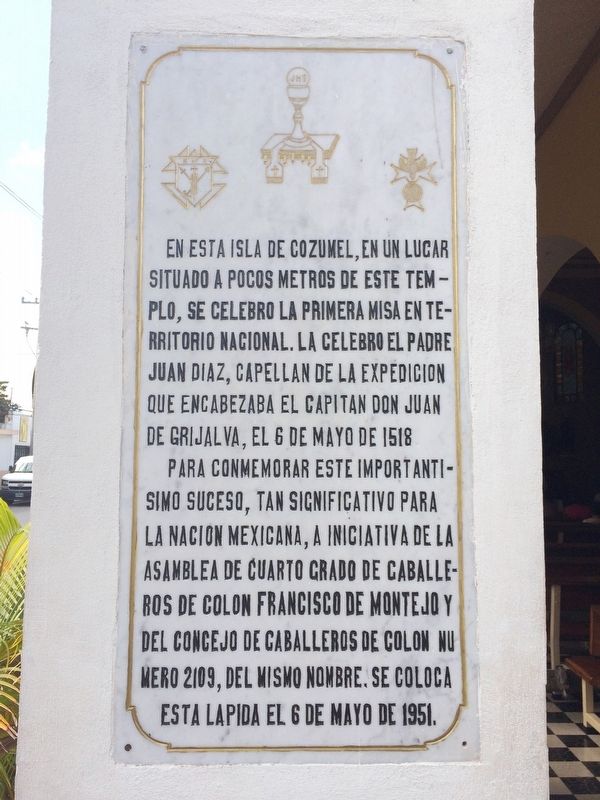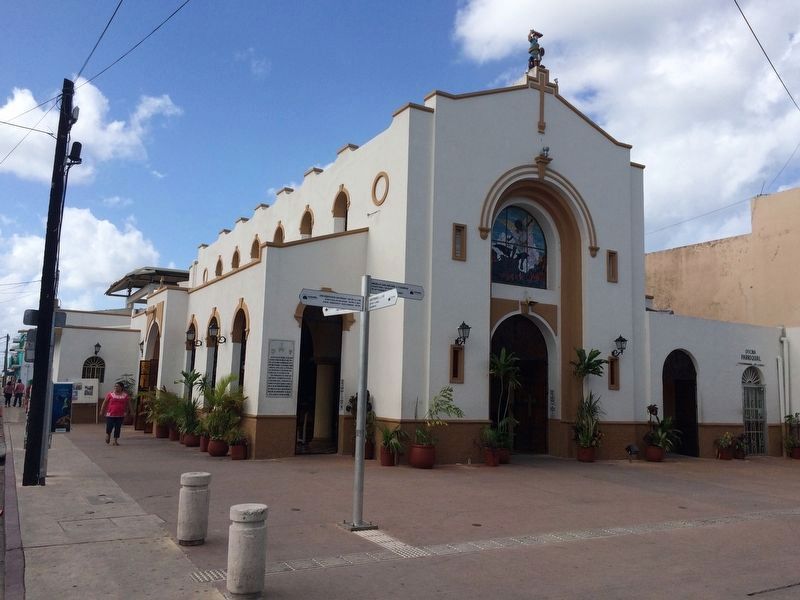San Miguel de Cozumel, Quintana Roo, Mexico — The Yucatan Peninsula (The Southeast)
The First Mass Celebrated in Mexico
situado a pocos metros de este templo,
se celebro la primera misa en territorio
nacional. La celebro el Padre
Juan Diaz, Capellan de la expedicion
que encabezaba el Capitan Don Juan
de Grijalva, el 6 de mayo de 1518.
Para conmemorar este importantismo
suceso, tan significativo para
la nación Mexicana, a iniciativa de la
Asamblea de Cuarto Grado de Caballeros
de Colon Francisco de Montejo y
del Concejo de Caballeros de Colon numero
2109, del mismo nombre. Se coloca
esta lapida el 6 de mayo de 1951.
On this island of Cozumel, a few meters from this temple, was held the first mass in what is now Mexico. It was celebrated by Father Juan Diaz, chaplain of the expedition headed by Captain Juan de Grijalva, on May 6, 1518.
To commemorate this most important event, so significant to the Mexican nation, this stone is placed at the initiative of the Assembly of the Fourth Degree of Knights of Columbus “Francisco de Montejo” and the Council of the Knights of Columbus number 2109, of the same name. This stone is placed on May 6, 1951.
Erected 1951 by Asamblea de Cuarto Grado de Caballeros de Colon Francisco de Montejo y del Concejo de Caballeros de Colon 2109.
Topics. This historical marker is listed in these topic lists: Churches & Religion • Colonial Era. A significant historical date for this entry is May 6, 1518.
Location. 20° 30.589′ N, 86° 56.889′ W. Marker is in San Miguel de Cozumel, Quintana Roo. Marker is at the intersection of 10a Avenida Sur and Avenida Benito Juárez, on the right when traveling south on 10a Avenida Sur. Touch for map. Marker is in this post office area: San Miguel de Cozumel QR 77609, Mexico. Touch for directions.
Other nearby markers. At least 8 other markers are within walking distance of this marker. Benito Juárez García (about 150 meters away, measured in a direct line); Cozumel's Tribute to the Defenders of the Nation (approx. 0.2 kilometers away); General Rafael E. Melgar (approx. 0.6 kilometers away); Monument to Gonzálo Guerrero (approx. 0.8 kilometers away); The Arrival of the Spanish in Cozumel (approx. 1.2 kilometers away); Lockheed T-33. (approx. 1.4 kilometers away); Tribute to the 201st Squadron of the Mexican Expeditionary Force (approx. 1.4 kilometers away); North American T-28A Trojan (approx. 1.4 kilometers away). Touch for a list and map of all markers in San Miguel de Cozumel.
Regarding The First Mass Celebrated in Mexico.
While there is some discussion about where the first Catholic mass was held in Mexico, this location in Cozumel is generally regarded as the first to be documented. Spain sent various early expeditions to explore Mexico, with the first in 1517, in what is now the area around Campeche, led by Francisco Hernández de Córdoba. While there is an assumption that a mass must have been held during that expedition, it was not until a year later in 1518 during the expedition of Juan de Grijalva that a documented mass was celebrated. Regardless of the exact date, we know that it is likely that the first Catholic mass occurred in the Yucatán Peninsula of Mexico during this early period of Spanish exploration. Unfortunately the arrival of Christianity was secondary to the Conquistadors' military strategy of submitting any new territory to their will and extracting as much wealth as possible from any newly invaded areas at the expense of its native inhabitants.
Credits. This page was last revised on April 7, 2019. It was originally submitted on February 8, 2017, by J. Makali Bruton of Accra, Ghana. This page has been viewed 570 times since then and 85 times this year. Photos: 1, 2. submitted on February 8, 2017, by J. Makali Bruton of Accra, Ghana.

